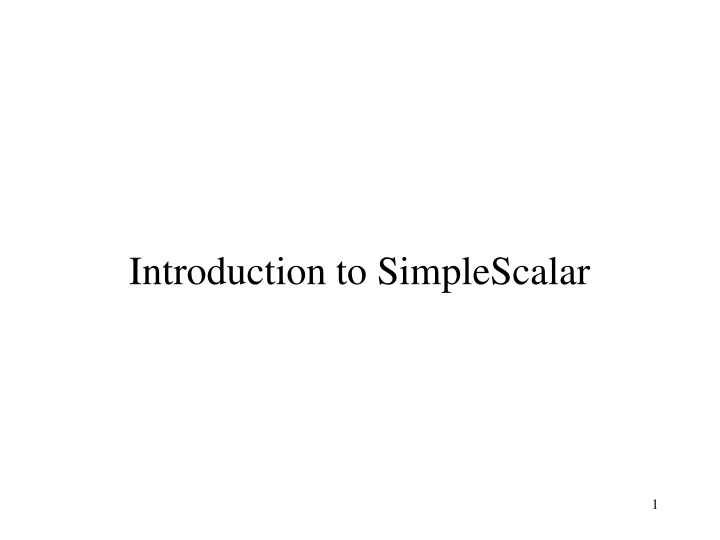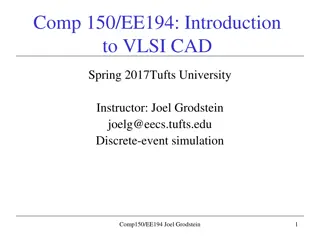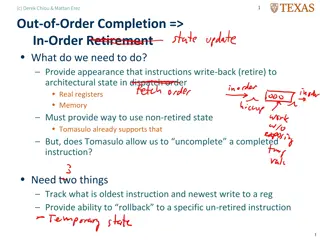Introduction to Architectural Simulation with SimpleScalar
Architectural simulation using tools like SimpleScalar allows for faster and more flexible software development cycles, exploration of design space, and validation before hardware availability. The taxonomy of simulation tools covers functional versus performance simulators, and trace-driven versus execution-driven approaches. The SimpleScalar Tool Set supports various ISAs and provides both functional and performance simulation capabilities, with advantages such as flexibility, extensibility, and portability.
Uploaded on Mar 18, 2025 | 0 Views
Download Presentation

Please find below an Image/Link to download the presentation.
The content on the website is provided AS IS for your information and personal use only. It may not be sold, licensed, or shared on other websites without obtaining consent from the author.If you encounter any issues during the download, it is possible that the publisher has removed the file from their server.
You are allowed to download the files provided on this website for personal or commercial use, subject to the condition that they are used lawfully. All files are the property of their respective owners.
The content on the website is provided AS IS for your information and personal use only. It may not be sold, licensed, or shared on other websites without obtaining consent from the author.
E N D
Presentation Transcript
Overview What is an architecturalsimulator? a tool that reproduces the behavior of a computing device Device Simulator Systemoutputs Systemmetrics Systeminputs Why we use a simulator? Leverage a faster, more flexible software development cycle Permit more design space exploration Facilitates validation before H/W becomes available Level of abstraction is tailored by design task Possible to increase/improve system instrumentation Usually less expensive than building a realsystem 2
A Taxonomy of Simulation Tools Shaded tools are included in SimpleScalar ToolSet 3
Functional vs. Performance Functional simulators Model the function of eachcomponent Does not have timingaccuracy Faster Performancesimulators Model system at finerdetail Timing in addition to functionality For example: Branch prediction accuracy vs. memorylatency 4
Trace- vs. Execution-Driven Trace-Driven Simulator reads a trace of the instructions captured duringa previousexecution Easy to implement, no functional componentsnecessary Execution-Driven Simulator runs the program(trace-on-the-fly) Hard toimplement Advantages No need to storetraces Register and memory values usually are not in trace Support mis-speculation cost modeling 5
SimpleScalar Tool Set Computer system design and analysis infrastructure Processor/device (behavioral)models build modeling applications that simulate real programsrunning on a range of modern processors and system Support many ISAs and I/O interfaces Alpha, PISA, ARM, and x86 instr.sets Hosted on most any Unix-likemachine Application Application Input/output Simplescalar Simulators Freely available for academic non-commercial use with source from www.simplescalar.com Performance results Host Machine 6
Advantages of SimpleScalar Highly flexible functional simulator + performance simulator Portable Host: virtual target runs on most Unix-like systems Target: simulators can support multipleISAs Extensible Source is included for compiler, libraries, simulators Easy to writesimulators Performance Sim-Fast: 10+ MIPS Sim-OutOrder: 350+ KIPS 7
Simulator Suite Sim-Cache Sim-BPred Sim-Fast Sim-Safe Sim-Profile Sim-Outorder -3900lines -performance -OoOissue -Branchpred. -Mis-spec. -ALUs -Cache -TLB -420lines -functional -4+MIPS -350lines -functional w/checks -900lines -functional -Lot ofstats -~1000lines -functional -Cachestats Performance Detail 8
Sim-Outorder Most complicated and detailed simulator Supports out-of-order issue and execution Provides reports branch prediction cache externalmemory various configuration 9
Specifying Sim-outorder Running a program sim-outorder [sim opts] program [program opts] e.g. $SIMPLESIM/simplesim-3.0/sim-outorder -config cfg_file bzip2_base.i386-m32-gcc42-nn dryer.jpg 10
Benchmark SPEC 2006 Six benchmarks (4 integer, 2 floating point) bzip2(INT) equake(FP) hmmer(INT) mcf(INT) milc(FP) sjeng(INT) 11
Installation of simplescalar Simplescalar 3.0 is already installed bg machines Path setup 1) log on into one of the bg machines 2) Go to your home directory:cd 3) >vim .cshrc (or gedit .cshrc) export SIMPLESIM=/home/scratch/massem/research/Simulators/sim plescalar > source .cshrc 4) To verify, run >echo $SIMPLESIM the return should be /home/scratch/massem/research/Simulators/simplescalar 12
Installation of simplescalar Create a local directory >mkdir simplescalar >cd simplescalar >cp -r $SIMPLESIM/simplesim-3.0/ss- benchmark ss-benchmark >cp -r $SIMPLESIM/simplesim-3.0/config config >cd ss-benchmark 13
Running Benchmarks Run benchmark (bzip2) >cd bzip2 >$SIMPLESIM/simplesim-3.0/sim-outorder - config ../../config/tmp.cfg bzip2_base.i386- m32-gcc42-nn dryer.jpg 14
Check results Check simulation results vim sim1.out (or gedit sim1.out) 15
Modify config Modify a parameter in the configfile >cd ../../config >vim tmp.cfg (or gedit tmp.cfg) - Increase L2 Data Cache Latency from 4 to 10 -cache:dl2lat 10 - Change output file name (-redir:sim sim2.out) - Save and close tmp.cfg 16
Re-run Benchmark Run benchmark (bzip2) >cd ss-benchmark >cd bzip2 >$SIMPLESIM/simplesim-3.0/sim-outorder config ../../config/tmp.cfg bzip2_base.i386-m32-gcc42-nn dryer.jpg 17
Check result Check simulation results vim sim2.out (or gedit sim2.out) 18
Global Simulator Options Supported on all simulators -print simulator helpmessage -enable debug message -quitimmediately -read config parameters from <file> -save config parameters into <file> -dumpconfig <file> Configuration files - To generate a configuration file: -dumpconfig<file> - Change parameters in <file> - Comments allowed in configuration file, # - Reload configuration file using: -config<file> -h -d -q -config <file> 19
Log into bg machines using SSH ssh <username>@bg1.cs.wm.edu You can use machines from bg1 to bg9 20
Running rest of benchmarks mcf > cdmcf > $SIMPLESIM/simplesim-3.0/sim-outorder config ../../config/tmp.cfg mcf_base.i386-m32-gcc42- nninp.in 21
hmmer > cd hmmer > $SIMPLESIM/simplesim-3.0/sim-outorder config ../../config/tmp.cfg hmmer_base.i386-m32-gcc42-nn bombesin.hmm 22
sjeng > cd sjeng > $SIMPLESIM/simplesim-3.0/sim-outorder config ../../config/tmp.cfg sjeng_base.i386-m32-gcc42- nn test.txt 23
milc > cdmilc > $SIMPLESIM/simplesim-3.0/sim-outorder config ../../config/tmp.cfg milc_base.i386-m32-gcc42-nn < su3imp.in 24
equake > cd equake > $SIMPLESIM/simplesim-3.0/sim-outorder config ../../config/tmp.cfg equake_base.pisa_little< inp.in > inp.out 25























